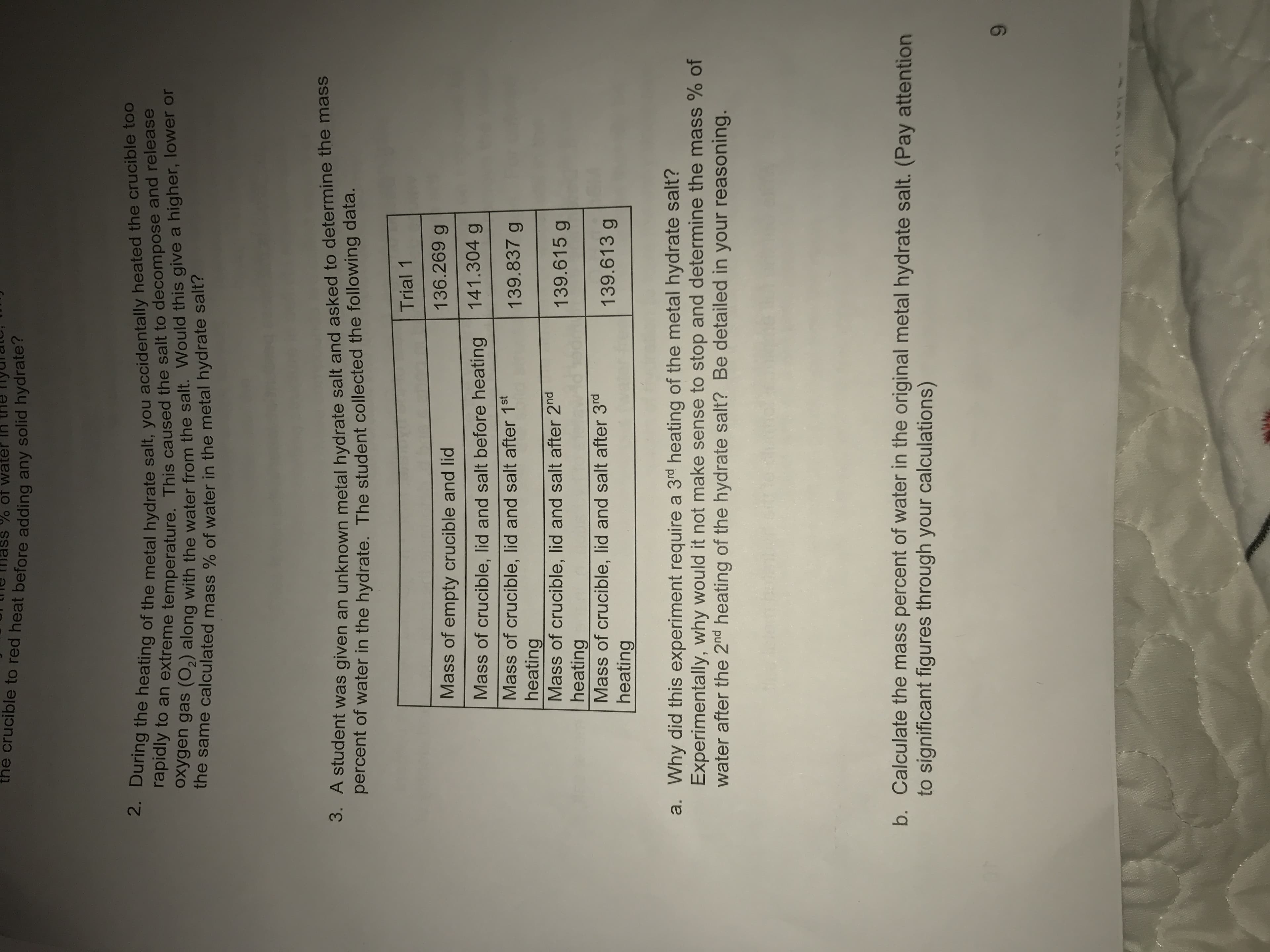the crucible to red heat before adding any solid hydrate? 2. During the heating of the metal hydrate salt, you accidentally heated the crucible too rapidly to an extreme temperature. This caused the salt to decompose and release oxygen gas (O2) along with the water from the salt. Would this give a higher, lower or the same calculated mass % of water in the metal hydrate salt? 3. A student was given an unknown metal hydrate salt and asked to determine the mass percent of water in the hydrate. The student collected the following data. Trial 1 Mass of empty crucible and lid 136.269 g Mass of crucible, lid and salt before heating 141.304 g Mass of crucible, lid and salt after 1st heating Mass of crucible, lid and salt after 2nd heating Mass of crucible, lid and salt after 3rd heating 139.837 g 139.615 g 139.613 g a. Why did this experiment require a 3rd heating of the metal hydrate salt? Experimentally, why would it not make sense to stop and determine the mass % of water after the 2nd heating of the hydrate salt? Be detailed in your reasoning. b. Calculate the mass percent of water in the original metal hydrate salt. (Pay attention to significant figures through your calculations) 6
the crucible to red heat before adding any solid hydrate? 2. During the heating of the metal hydrate salt, you accidentally heated the crucible too rapidly to an extreme temperature. This caused the salt to decompose and release oxygen gas (O2) along with the water from the salt. Would this give a higher, lower or the same calculated mass % of water in the metal hydrate salt? 3. A student was given an unknown metal hydrate salt and asked to determine the mass percent of water in the hydrate. The student collected the following data. Trial 1 Mass of empty crucible and lid 136.269 g Mass of crucible, lid and salt before heating 141.304 g Mass of crucible, lid and salt after 1st heating Mass of crucible, lid and salt after 2nd heating Mass of crucible, lid and salt after 3rd heating 139.837 g 139.615 g 139.613 g a. Why did this experiment require a 3rd heating of the metal hydrate salt? Experimentally, why would it not make sense to stop and determine the mass % of water after the 2nd heating of the hydrate salt? Be detailed in your reasoning. b. Calculate the mass percent of water in the original metal hydrate salt. (Pay attention to significant figures through your calculations) 6
Introductory Chemistry: A Foundation
9th Edition
ISBN:9781337399425
Author:Steven S. Zumdahl, Donald J. DeCoste
Publisher:Steven S. Zumdahl, Donald J. DeCoste
Chapter9: Chemical Quantities
Section: Chapter Questions
Problem 36QAP
Related questions
Question
100%
Please answer questions 3a and 3b. Questions are provided in the attached image. Thank you.

Transcribed Image Text:the crucible to red heat before adding any solid hydrate?
2. During the heating of the metal hydrate salt, you accidentally heated the crucible too
rapidly to an extreme temperature. This caused the salt to decompose and release
oxygen gas (O2) along with the water from the salt. Would this give a higher, lower or
the same calculated mass % of water in the metal hydrate salt?
3. A student was given an unknown metal hydrate salt and asked to determine the mass
percent of water in the hydrate. The student collected the following data.
Trial 1
Mass of empty crucible and lid
136.269 g
Mass of crucible, lid and salt before heating
141.304 g
Mass of crucible, lid and salt after 1st
heating
Mass of crucible, lid and salt after 2nd
heating
Mass of crucible, lid and salt after 3rd
heating
139.837 g
139.615 g
139.613 g
a. Why did this experiment require a 3rd heating of the metal hydrate salt?
Experimentally, why would it not make sense to stop and determine the mass % of
water after the 2nd heating of the hydrate salt? Be detailed in your reasoning.
b. Calculate the mass percent of water in the original metal hydrate salt. (Pay attention
to significant figures through your calculations)
6
Expert Solution
This question has been solved!
Explore an expertly crafted, step-by-step solution for a thorough understanding of key concepts.
This is a popular solution!
Trending now
This is a popular solution!
Step by step
Solved in 4 steps with 1 images

Knowledge Booster
Learn more about
Need a deep-dive on the concept behind this application? Look no further. Learn more about this topic, chemistry and related others by exploring similar questions and additional content below.Recommended textbooks for you

Introductory Chemistry: A Foundation
Chemistry
ISBN:
9781337399425
Author:
Steven S. Zumdahl, Donald J. DeCoste
Publisher:
Cengage Learning

Chemistry & Chemical Reactivity
Chemistry
ISBN:
9781337399074
Author:
John C. Kotz, Paul M. Treichel, John Townsend, David Treichel
Publisher:
Cengage Learning

Chemistry for Engineering Students
Chemistry
ISBN:
9781337398909
Author:
Lawrence S. Brown, Tom Holme
Publisher:
Cengage Learning

Introductory Chemistry: A Foundation
Chemistry
ISBN:
9781337399425
Author:
Steven S. Zumdahl, Donald J. DeCoste
Publisher:
Cengage Learning

Chemistry & Chemical Reactivity
Chemistry
ISBN:
9781337399074
Author:
John C. Kotz, Paul M. Treichel, John Townsend, David Treichel
Publisher:
Cengage Learning

Chemistry for Engineering Students
Chemistry
ISBN:
9781337398909
Author:
Lawrence S. Brown, Tom Holme
Publisher:
Cengage Learning

Chemistry & Chemical Reactivity
Chemistry
ISBN:
9781133949640
Author:
John C. Kotz, Paul M. Treichel, John Townsend, David Treichel
Publisher:
Cengage Learning

Chemistry
Chemistry
ISBN:
9781305957404
Author:
Steven S. Zumdahl, Susan A. Zumdahl, Donald J. DeCoste
Publisher:
Cengage Learning
